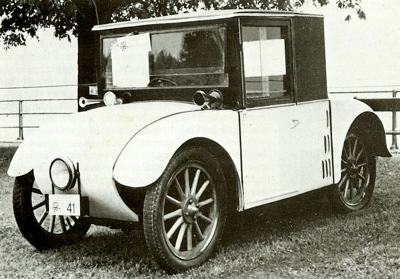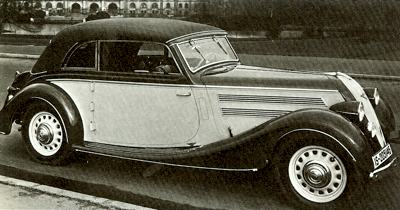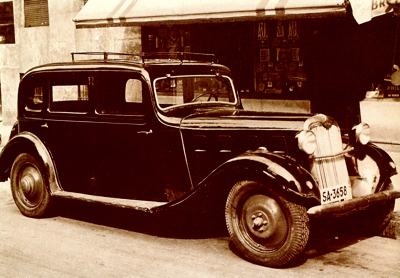Hannoversche Mashinenbau AG Vorm Georg Egestorff
The Hanomag company dates back to 1835 when Georg Egestorff founded a company called Eisen-Giesserei und Maschinenfabrik Hannover in Hanover-Linden, Germany, to build small steam engines. They soon started making farm machinery and in 1846 built their first railway locomotive for the Hannover State Railways. By 1870 they had made 500 locomotives and in 1871 changed their name to Hannoversche Maschinenbau AG.
The companies first road vehicle, a steam truck, was manufactured in 1905. Private cars did not appear for another nineteen years but, when the little Hanomag 2/10 PS (PS are German horsepower) two-seater made its bow in 1924, it was exactly the car for Germany's economic climate at that time.
The diminutive Hanomag 2/10 was one of the most refined cycle-cars ever built, with full-width streamlined coachwork that enabled driver and passenger to sit abreast. There was a closed version (an unusual thing for a car of this type) with sliding side-windows. For economy, there was a single cyclops headlight in the car's nose; the single-cylinder 499cc ohv engine lived at the rear, driving the narrow rear axle through a chain.
The 'Kommissbrot'
The Hanomag 2/10 sat on four spindly wooden wheels, which contrasted oddly with the dumpy bodywork, whose unorthodox shape earned the car the nickname of 'Kommissbrot' (Army Loaf). Developing all of 10 bhp when driven in anger, the engine nevertheless could propel the Kommissbrot at 40 mph, and the marque soon earned itself a sporting reputation which was probably due as much to the fact that those who drove Hanomags could afford nothing better, as it was to any actual speed capabilities, as even stripped open versions of this car were hard pressed to better 45 mph.
Von Buthenuth and Karl Haeberle
The Kommissbrot, however, sold well: by the time production ended in 1928, a total of 15,775 had been built. Its successor was a more conventional machine, with a front-mounted, 776cc, four-cylinder engine. This 3/16 PS Hanomag could also be had with a 745cc power unit, which made it eligible for the 750cc competition class; in this form, it was driven by Hanomag's works drivers Von Buthenuth and Karl Haeberle.
A more potent version of this car appeared in 1929, with a Roots-type supercharger which boosted power sufficiently to warrant the car's entry in a race meeting at the
Nurburgring in 1929. However, it failed to finish. Further new models appeared, among them the Garant and the Kurier, both with 1090cc power units; a team of 1090cc Hanomags was entered in the 1931 Alpine Trial, with Von Buthenuth, Pollich, Von Raffray and Frau L. Roehrs as drivers.
All four cars climbed the Stelvio Pass without loss of points, and their performance throughout was an outstanding feature of the Trial. Von Buthenuth and Pollich finished without any penalty points, but waited outside the final control so as to check in simultaneously with Liliane Roehrs, who had lost four points on time. As all three now finished with four penalty points, they became joint winners of the 1100cc class, and the Trial organisers had to present three Coupes des Glaciers instead of one! Larger models, the 1494cc Rekord and the 2250cc Sturm, also appeared, available with saloon, cabriolet or open two-seater sports coachwork.
 The first Hanomag was the 2/10 PS two-seater cycle-car. It would soon be christened the Kommissbrot, or Army Loaf. It was powered by a 499cc rear mounted engine.
The first Hanomag was the 2/10 PS two-seater cycle-car. It would soon be christened the Kommissbrot, or Army Loaf. It was powered by a 499cc rear mounted engine.
 1937 Hanomag Cabriolet, powered by a 2250cc engine.
1937 Hanomag Cabriolet, powered by a 2250cc engine.
 1938 Hanomag 1.5 litre Rekord sedan.
1938 Hanomag 1.5 litre Rekord sedan. |
The Hanomag Diesel Rekord
During the 1930s the Hanomags' lines became more and more streamlined, until they became almost futuristic. It was the Hanomags' clean lines which gave the cars a good road performance, but what really brought the marque to the public notice was its pioneering use of the diesel engine for its private cars. The Diesel Rekord appeared at the 1936 Berlin Show, its 1910cc engine developing 35 bhp. There was also a 1634cc version, shown at the Paris Exhibition that year; apart from its power unit, the rubber-edged wings and running boards, intended to eliminate parking scrapes, attracted press attention.
Hanomag War Production
A streamlined version of the Diesel Rekord was built in 1939 to attempt
speed records; it achieved a number of world-record speeds on the Dessau Autobahn, including a maximum speed of 95 mph. That year, an
aerodynamic saloon went into production, with a claimed top speed of 70 mph-plus on a mere 32 bhp power output. During World War 2 the Hanomag factory made military vehicle engines, a military version of their heavy tractor renamed the SS-100, and half track troop carriers. Hanomag 20 B, a 4-wheel-drive Small Unit-Personnel Carrier was produced 1937-1940 (approx. 2000) under the parentage of Stoewer. Capacity problems by Stoewer resulted in co-production by both BMW and Hanomag.
Together the three manufacturers made around 10,000 units. The special 4-wheel-steering system was fitted on most models. Operating a "lock-level" between the front seats made the steerable rear axle turn sideways to a certain angle. The single most important and iconic military vehicle to be designed and built by Hanomag during World War 2 was the Sd.Kfz. 251 half-track (commonly called simply "the Hanomag") with a total production numbering just over 15,000. Built to protect and transport the Panzergrenadier mechanized infantry forces, it was by far the most common German armoured troop-carrying vehicle of World War 2, and a direct precursor to the armoured personnel carriers of today.
In comparison to the most common Allied half-track of the war, the M3 Half-track, the Sd.KFz 251 was slower and lower-powered but with thicker, sloping side armor that provided better protection; the flat-sided M3 was at one point panned as the "Purple Heart Box" for being unable to stop 7.92mm bullets at close range, while the Hanomag's sloping side armor deflected the .30-caliber bullets of the Allies with no similar issue.
The Hanomag Partner
After the war Hanomag production resumed making trailer units followed by tractors and in 1949 a 1.5 ton truck. A new Hanomag, the Partner, was developed - it had a 697cc three-cylinder two-stroke engine and some sporting pretensions; front-wheel drive and three-seater coachwork also formed part of the specification. However, although the model was exhibited at the
1951 Frankfurt Motor Show, the project was stillborn. Hanomag then abandoned car production altogether, concentrating their subsequent efforts on the production of light and medium commercial vehicles. Rudolph Hiller, who had been president of Phänomen trucks, joined the board and restructured the company by arranging for it to join the Rheinstahl consortium in 1952. In 1964, Rheinstahl took over Henschel-Werke and in a reverse of history the company was merged with Hanomag.
Hanomag Perfekt 400e
The farm tractor operation was sold to Massey Ferguson and in 1969 the truck making division of Hanomag-Henschel went to Daimler Benz, leaving the Hannover works making earth-moving machinery for Massey Ferguson. In 1989, the world's second largest construction machine manufacturer, Komatsu, bought a share of Hanomag AG and since 2002 Komatsu Hanomag GmbH has been a 100% subsidiary of the global company. Apart from the post-war prototypes, car production remains in the history books of the company - and as a lost marque on Unique Cars and Parts, we record the end of production as 1939.



